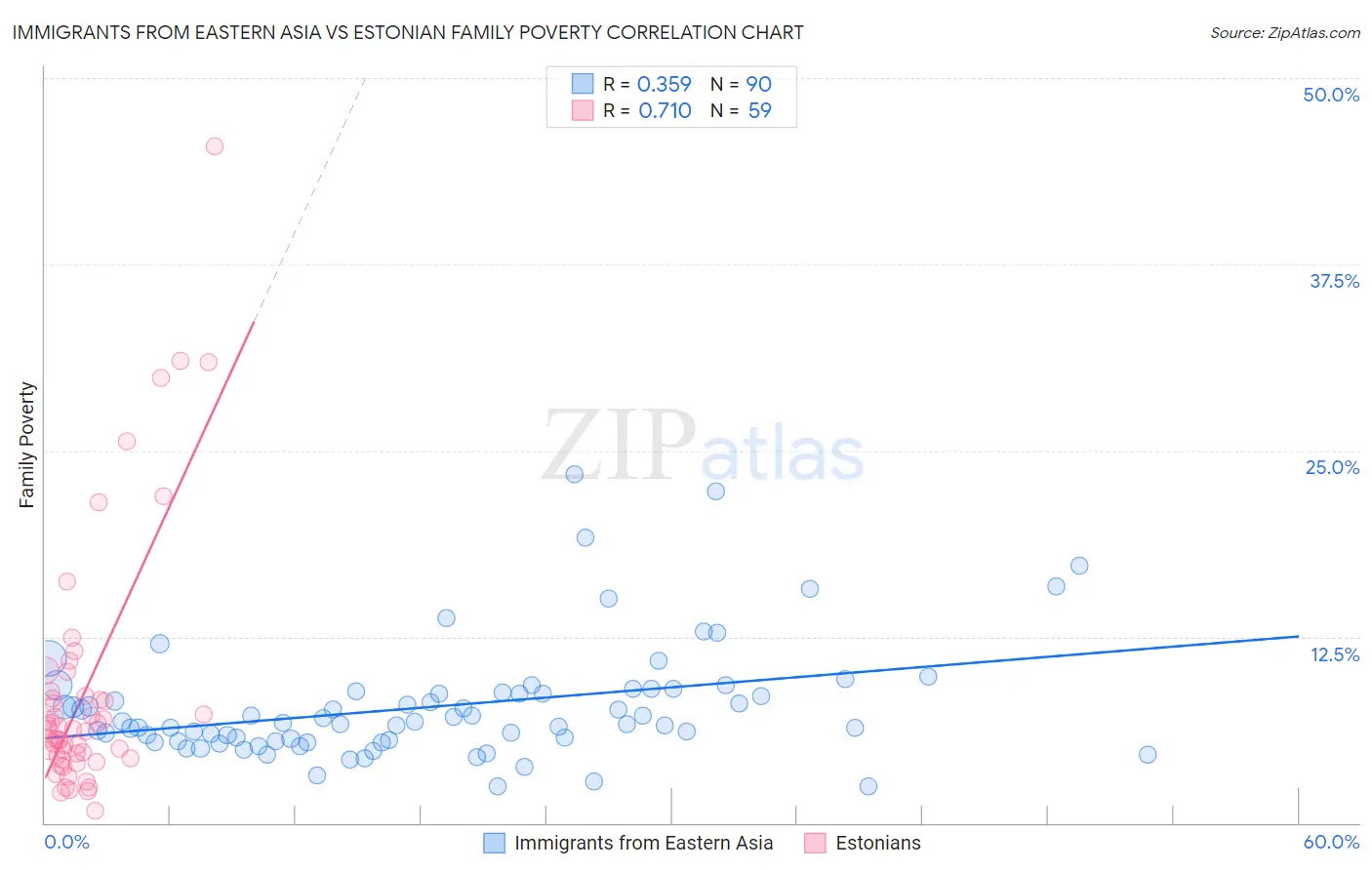Immigrants from Eastern Asia vs Estonian Family Poverty
COMPARE
Immigrants from Eastern Asia
Estonian
Family Poverty
Family Poverty Comparison
Immigrants from Eastern Asia
Estonians
7.7%
FAMILY POVERTY
98.7/ 100
METRIC RATING
55th/ 347
METRIC RANK
7.5%
FAMILY POVERTY
99.4/ 100
METRIC RATING
37th/ 347
METRIC RANK
Immigrants from Eastern Asia vs Estonian Family Poverty Correlation Chart
The statistical analysis conducted on geographies consisting of 497,339,413 people shows a mild positive correlation between the proportion of Immigrants from Eastern Asia and poverty level among families in the United States with a correlation coefficient (R) of 0.359 and weighted average of 7.7%. Similarly, the statistical analysis conducted on geographies consisting of 123,321,798 people shows a strong positive correlation between the proportion of Estonians and poverty level among families in the United States with a correlation coefficient (R) of 0.710 and weighted average of 7.5%, a difference of 2.6%.

Family Poverty Correlation Summary
| Measurement | Immigrants from Eastern Asia | Estonian |
| Minimum | 2.4% | 0.86% |
| Maximum | 23.4% | 45.5% |
| Range | 21.0% | 44.6% |
| Mean | 7.8% | 8.8% |
| Median | 6.8% | 6.3% |
| Interquartile 25% (IQ1) | 5.5% | 4.3% |
| Interquartile 75% (IQ3) | 8.7% | 8.6% |
| Interquartile Range (IQR) | 3.2% | 4.3% |
| Standard Deviation (Sample) | 3.9% | 8.5% |
| Standard Deviation (Population) | 3.8% | 8.4% |
Demographics Similar to Immigrants from Eastern Asia and Estonians by Family Poverty
In terms of family poverty, the demographic groups most similar to Immigrants from Eastern Asia are Immigrants from Sweden (7.7%, a difference of 0.030%), Swiss (7.7%, a difference of 0.040%), Immigrants from Serbia (7.7%, a difference of 0.040%), Indian (Asian) (7.7%, a difference of 0.10%), and Immigrants from Moldova (7.7%, a difference of 0.26%). Similarly, the demographic groups most similar to Estonians are Turkish (7.5%, a difference of 0.17%), Bolivian (7.5%, a difference of 0.24%), Carpatho Rusyn (7.5%, a difference of 0.31%), Slovene (7.5%, a difference of 0.34%), and Immigrants from Australia (7.6%, a difference of 0.64%).
| Demographics | Rating | Rank | Family Poverty |
| Turks | 99.4 /100 | #36 | Exceptional 7.5% |
| Estonians | 99.4 /100 | #37 | Exceptional 7.5% |
| Bolivians | 99.3 /100 | #38 | Exceptional 7.5% |
| Carpatho Rusyns | 99.3 /100 | #39 | Exceptional 7.5% |
| Slovenes | 99.3 /100 | #40 | Exceptional 7.5% |
| Immigrants | Australia | 99.2 /100 | #41 | Exceptional 7.6% |
| Scandinavians | 99.1 /100 | #42 | Exceptional 7.6% |
| Immigrants | Austria | 99.1 /100 | #43 | Exceptional 7.6% |
| Germans | 99.0 /100 | #44 | Exceptional 7.7% |
| Okinawans | 98.9 /100 | #45 | Exceptional 7.7% |
| Tongans | 98.9 /100 | #46 | Exceptional 7.7% |
| Immigrants | Czechoslovakia | 98.9 /100 | #47 | Exceptional 7.7% |
| Immigrants | Sri Lanka | 98.9 /100 | #48 | Exceptional 7.7% |
| Immigrants | Bolivia | 98.9 /100 | #49 | Exceptional 7.7% |
| Immigrants | North Macedonia | 98.9 /100 | #50 | Exceptional 7.7% |
| Immigrants | Moldova | 98.8 /100 | #51 | Exceptional 7.7% |
| Indians (Asian) | 98.8 /100 | #52 | Exceptional 7.7% |
| Swiss | 98.8 /100 | #53 | Exceptional 7.7% |
| Immigrants | Sweden | 98.8 /100 | #54 | Exceptional 7.7% |
| Immigrants | Eastern Asia | 98.7 /100 | #55 | Exceptional 7.7% |
| Immigrants | Serbia | 98.7 /100 | #56 | Exceptional 7.7% |